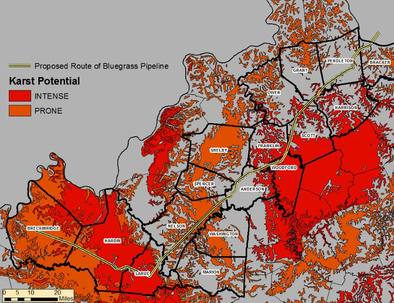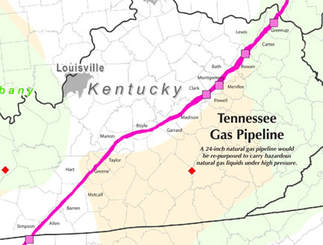|
By Cameron Baller: UK Greenthumb, Just Transition Working Group Steering Committee, Pipelines and Natural Gas Working Group The 2016 presidential election threw every federal agency for a spin, few more so than the Federal Energy Regulatory Commission (FERC). A little known agency, the FERC is responsible for regulating nuclear energy and oil and gas pipeline infrastructure, among other things. After Donald Trump was elected, members of the FERC leadership quit abruptly, leaving the agency without enough administrators to make decisions. They had been stuck in limbo, stalling all new regulations and decisions about pipelines. This purgatory is where the Kinder Morgan Pipeline project has been for the past few months… but no longer. This dangerous pipeline project is lurking under our radar and it is critical that we prepare now so that we can stop it in its tracks. Read on for more information and to learn how to join us in stopping this pipeline.  Not Kentucky’s First Rodeo There is a storied legacy of companies trying to snake dangerous pipeline infrastructure through Kentucky. In 2013, the Williams and Boardwalk Pipeline Partners proposed the Bluegrass Pipeline. In an effort to intimidate landowners into selling their land for the construction of the pipeline, the company told landowners that it would use eminent domain to take their land for the project, which would be a bad financial deal for the landowners. A broad array of constituents came together, including landowners, advocacy groups, policymakers, and even a group of singing nuns to fight the project. Several landowners formed a blockade, refusing to sell their land to the pipeline company, while other allies pursued legal action. In 2015, the Kentucky court system determined that the Bluegrass Pipeline could not use eminent domain to seize land for the project, functionally stopping the pipeline. The court ruling hinged on a key fact: the pipeline was carrying natural gas liquids (NGLs) and NOT natural gas. NGLs are not methane and are not used primarily for energy. They are co-products that are obtained, along with methane, from the natural gas extraction process. Rather than being used for heat and power, they are used as inputs for plastics and chemical manufacturing. This distinction was critical in the court’s eminent domain decision. Another important distinction between NGLs and natural gas is that NGLs vaporize and, because of their relative weight, displace the air. In simple terms, this means that when an NGL pipeline leaks, the vapors could suffocate anyone and everyone within the leak area.  Credit: Kentuckians For The Commonwealth Credit: Kentuckians For The Commonwealth A New Pipeline Waiting to Strike Not long after the Bluegrass Pipeline was defeated, Kinder Morgan began exploring their own NGL pipeline project. This time, the dangers are even more severe. The Tennessee Gas Pipeline is owned by a subsidiary of Kinder Morgan and has carried actual natural gas from South to North for over 70 years. Now, Kinder Morgan hopes to “abandon” this pipeline (to do so, it must first get the approval from the FERC) and then sell the pipeline to another one of its subsidiaries, the Utica-Marcellus Texas Pipeline (UMTP). UMTP would re-purpose the pipeline, flip the flow so that it goes from North to South, and send NGLs along the pipeline instead of natural gas. There are a few important reasons this project is even more dangerous than the Bluegrass Pipeline. The existing pipeline is more than 70 years old, therefore subject to the normal wear and tear that 70 years of use will bring, and no longer meets today’s pipeline construction safety standards. In an area with geology as dangerous as Kentucky’s infamous karst, where sinkholes gobble up several Corvettes at a time, it is terrifying to think that we are considering transporting dangerous NGLs by pipeline, let alone transporting them through a pipeline so old and out of standard. Furthermore, they are both flipping the flow of the pipeline and sending new materials down it, these are both stressors that the pipeline has not been subjected to and could present unpredictable problems and an increased risk of leaks. Finally, Kinder Morgan observed and learned from the Bluegrass Pipeline fight. In re-purposing an existing pipeline, they may be able to utilize the existing land easements, circumventing the need for eminent domain. These tactics go against the clear demands of Kentuckians and require new and creative strategies in response. Re-organizing in the New Landscape
In August, the FERC regained quorum after Trump appointed new commissioners to the agency. Given the political leanings of these appointees, we should not be surprised when they approve Kinder Morgan’s request to “abandon-in-place,” functionally granting the company a blank check to do the re-purposing. As the official comment period is over, and the die seem to be cast in terms of the FERC, it seems like the most important action now would be to prepare for that announcement and get out ahead of it. The good news is we are not beginning from scratch. Organizations across Kentucky have been working on this issue since the beginning, including the Kentucky Resources Council (KRC), Kentucky Heartwood, Kentuckians for the Commonwealth (KFTC), the Kentucky Environmental Foundation, among others. However, organizing efforts have stalled as the FERC lost its ability to make decisions. It is essential that we now re-energize resistance efforts before it is too late. With that goal in mind, the Kentucky Student Environmental Coalition (KSEC) has created a new Pipelines and Natural Gas Working Group (PNWG), which is focused on stopping the Kinder Morgan Pipeline project. We plan to work with other state and campus organizations, local communities and government officials to create a multi-layered resistance effort sufficient to block the project. We cannot hope to tackle this issue alone. Following the lead of the Bluegrass Pipeline resistance movement, we hope be a part of creating a diverse resistance movement across the state that can demonstrate a unified voice against the pipeline. We are more powerful than Kinder Morgan, but only together. In the coming weeks and months, we will be reaching out to a variety of stakeholders and developing tactics that allow everyone to be a part of this resistance. For now, informing yourself on this issue and preparing to become a part of the response effort are critical. We will fight for our future and we will no longer be ignored.
0 Comments
Your comment will be posted after it is approved.
Leave a Reply. |
AboutThe Young Kentuckian is a blog of the Kentucky Student Environmental Coalition where youth share their work and ideas for Kentucky's bright future. Follow The Young Kentuckian on Facebook!
Categories
All
Archives
March 2023
|


